The article is devoted to the results of the archaeological research of the Saka-Wusun burial ground of Karatuma. The Saka-Wusun issue despite of the long history of the study still requires additions to the factual base. A number of key issues related to the ethnic history, economic activities, social structure of the Zhetysu tribes need to be clarified. In this light, the results of excavations of the Karatuma burial ground acquire a high degree of relevance. The investigation of 167 mounds during the excavations at the burial ground in 2010 made it possible to obtain a very wide data series at once. The collection of the burial ground includes a number of interesting findings: armament, objects of worship and belt set. Mass material is ceramic crockery and paleoanthropological collection. Comparative analysis of the inventory, as well as radiocarbon dating analysis aided to date the burial to V-III BC. The results of the excavations at Karatuma burial ground confirm existing theories about the ethnic and cultural attribution of the memorials of the region, their economic activities and intercultural contacts. At the same time they allow to identify new challenges in the study of social structure in the saka-wusun period.
1. Introduction
Early Iron Age in South-eastern Kazakhstan (Zhetysu) is one of the well-studied dimension in the Kazakhstan archeology. Significant archaeological material, which became one of the bases for the reconstruction of the history of the region in the era of early nomads has been gained for more than half a century of study. The population of the region in the early Iron Age is traditionally associated with the tribes of Saka- tigraxauda (VII-III BC) and the Wusun (III BC – IV AD.) [1; 3]. The researchers also registered the presence of the Yuezhi and Xiongnu ethnic components [2; 359, 3; 34, 4; 67]. The Saka and Wusun inhabited almost the entire Zhetysu region between the Tien Shan and the lake Balkhash. However, the greatest number of memorials is located in the foothills of Tien Shan, as a result of favorable natural conditions.
However, Saka-Wusun issues remains valid, due to a number of issues which are still under development. In many ways they are caused by the mismatch between data in written sources and the results of archaeological research. In particular, it is a problem of the Wusun resettlement in North Tien Shan. In Soviet historiography chronological boundary between Saka and Wusun periods was defined as a frontier between IV and III BC. [1; 139, 2; 359]. However, according to Chinese sources, the Wusun resettled in this region in the first half of II BC. Moreover, Chinese sources determine the Wusun as pure nomads, while archeologists found evidence of a significant amount of agriculture in Saka and Wusun period. The trend to align the data of written and archaeological sources needs new factual material.
In this light, a wide range of data obtained during the study of Karatuma burial ground has high relevance. The history of the study of the burial ground has 2 phases: 1960s and 2009–2010.
Due to the first phase some mounds of the burial ground were researched. As a result, the main characteristics of the funeral ceremony such as the size and shape of mounds and burial pits as well as the composition of the accompanying inventory, were determined. During the excavations of those years an outstanding discovery — a sample script was found at the bottom of the stone vessel [5; 58].
In 2009 exploratory expedition LLP «Archaeological Expertise» determined that the territory of the burial ground is located in the area of the construction of the railway «Zhetygen – Khorgas». In 2010 research work of excavations of the mounds, located in the area of railway construction was organized. In total 167 mounds belonging to different clusters of the burial ground were studied in 2010.
2. Physiography of the Karatuma burial ground location.
The Karatuma burial ground is situated in the south-eastern Kazakhstan on the foothills of the northern spurs of the Tien Shan Mountains nearby the borders with Kyrgyzstan and China (Fig. 1). The burial ground is related to the sub-region, limited by the northern foothills of the Trans-Ili Alatau mountains, stretching for 280 km in latitude from the Shu River to Shelek (Fig. 2). Valleys of the rivers flowing down from its slopes outstand by a high concentration of ancient and medieval memorials.
- Climate. The Karatuma burial ground location is characterized by relatively favorable climate conditions. The average air temperature in the foothill zone is between + 8 0C to + 9 0C. The warmest month of the year is July, where as January is the coldest month. The absolute maximum in summer is + 42 〇ü. Autumn transit of temperature through 0 0C occurs in the middle of November. In spring the pass to the temperatures above zero occurs in the middle of March. Thus the duration of the warm period is 8 - 9 months, which provides a long enough vegetation season.
- Geomorphology. At the exit of the Trans-Ili Alatau mountain gorges the rivers form the alluvial fans consisting of sandy-clay alluvium, which is extremely favorable for settlement and economic activities. Calm relief and sloping terrain give great opportunities for irrigable agriculture. As nowadays ancient and medieval people were able to exploit skillfully the potential of these oases, as it is evidenced by numerous burial grounds, settlements and mounds.
The Karatuma burial ground is located on one of the largest alluvial fans of the Shelek River, at the far eastern spurs of the mountain ridge. The remarkable amount of burial mounds indicates a high density of population in these areas. On both banks of the Shelek River royal burial mounds were discovered, including Chilik burial ground with the conoid and pyramidal burial mounds. And almost the entire periphery of the Shelek alluvial fan is occupied by the burial fields of ordinary population or people with similar social status.
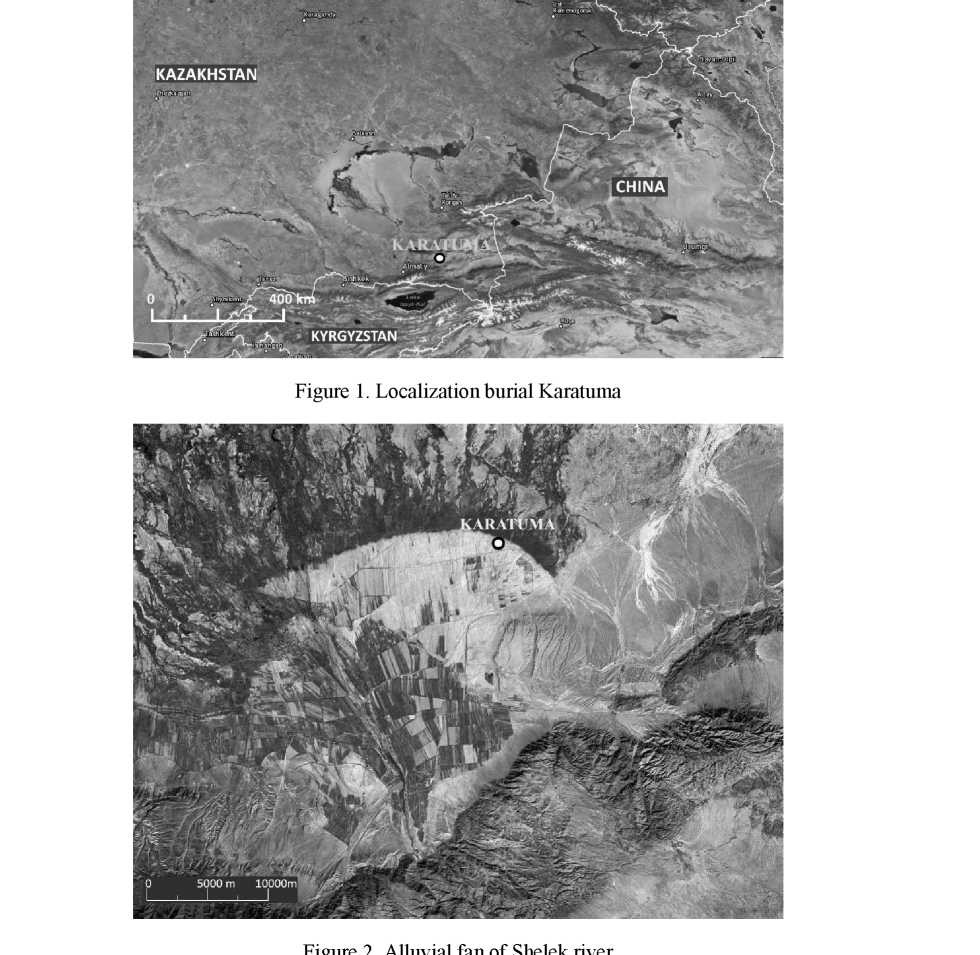
2.3. Watering. The northern slope of the Trans-Ili Alatau is characterized by significant humidity. Annually there are two minimums in precipitation — in winter and summer, and two peaks — in spring (April – May) and lowering autumn (October – November).
The Shelek River is one of the largest left tributaries of the Ili River, the main waterway of the SouthEastern Kazakhstan. Shelek generally receives water from glaciers and snow packs, melting in the alpine zone, as well as precipitation in the form of rain. Accordingly to the power conditions, flow regime is characterized by a significant spring-summer freshet. Today, almost entire territory of the Shelek alluvial fan is used for irrigable agriculture because of favorable natural conditions.
3. Description of the Karatuma burial ground. The Karatuma burial ground occupies the north-eastern foot of the Shelek alluvial fan. Its length is 3 km. Within the frames of the burial ground mounds form several local groups (clusters), separated from each other by free spaces extending to 0.3–0.5 km (Fig. 3).
These congestions exhibit high density and cover territories along the shallow dry river channels, spreading radially from the top of the alluvial fan. In most cases it is possible to trace the chains, the orientation of which coincides with these channels. The Karatuma burial ground includes 1070 mounds built of earth and fine gravel. The height of the burial mounds varies from 0.1 to 1.3 m, the diameter changes between 4 and 14 m. The mounds contain from 1 to 4 burial pits without alcove. The mounds with only burial pit prevail (Fig. 4). The burial pit shapes are elongated oval or rectangle. The orientation is dominantly eastwest with some deviations.
Buried people laid with their heads pointing westwards. In the burial pits from 1 to 3 individuals were discovered. In total in 167 investigated burial mounds there were the remains of 237 buried individuals.
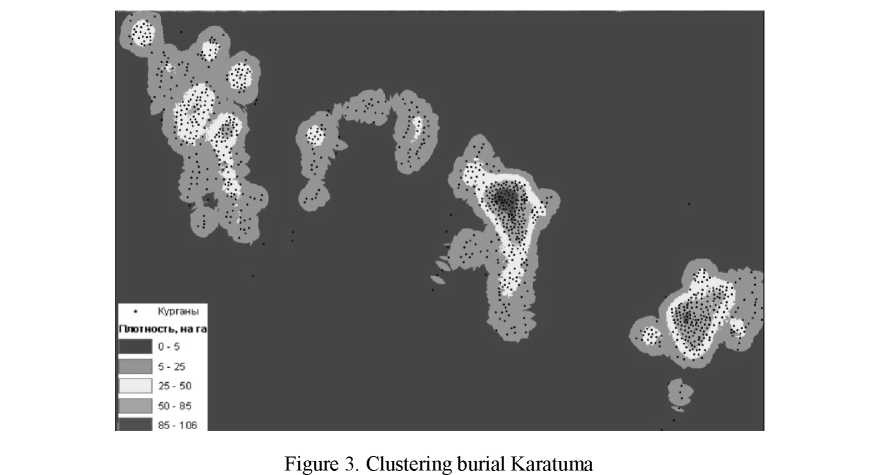
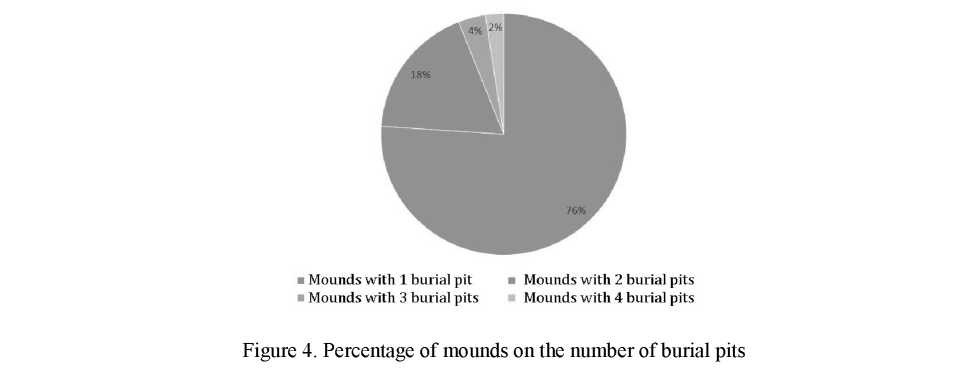
The racial type of the buried is European with a small admixture of Mongoloid. An increased number of injuries on the skull is noted. Odontological research has shown an increased incidence of dental caries in comparison with the memorials of Western Kazakhstan, which had a synchronous sampling [6].
4. Accompanying
Funerary Objects generally are quite poor and monotonous. Mainly it is presented by ceramic vessels, occasionally iron knives, things of belt set, extremely rarely weapon. The burials are characterized by a high degree of robbery (89 %) and poor preservation of the remains and equipment. The burial pits are dug in the alluvial gravel soil at the border of the waterlogged Shelek delta and it must be assumed that the groundwater, rising occasionally influenced on the state of the burials.
4.1 Objects of weapon. A characteristic feature of this burial ground, as well as other burial grounds of this kind, is a small amount of armaments. This significant difference between the Saka-Wusun burial ceremony in Zhetysu from other Saka cultures reflects its cultural specification.
A few weapon objects found during the research of Karatuma burial ground can be referred to the arsenal of early Eurasian nomads. They are an iron dagger from the mound 116 (Fig. 5, 1) and quiver set from the mound 166 (Fig. 5, 2).
The dagger of Prokhorov type dates back to IV - II BC [7; 2]. It refers to the type 5 of group 1 according to the classification of blades from Zhetysu and Tien Shan, proposed by S.S. Ivanov [8; 40].
The remains of the quiver set include a quiver shield of nonferrous metal and 5 iron arrowheads.
The quiver shield is interesting doe to the composition made on its surface (Fig. 5, 3). It includes images of feline predators in combination with floral ornaments. Iron arrowheads are classified as of three-bladed tanged type with a triangular shape of the blade and protruding stingers (Fig. 5, 2). In general, the quiver set dates to VI - III BC [7; 3].
Belt set. Just as the weapon, objects of a belt set are likely to have status characteristics. Among those, crutches-shaped pendants can be noted in the collection of Karatuma burial ground. An important characteristic of this category of findings is their chrono-diagnostic properties. The systematization of crutches-shaped pendants existing today allows us to get a fulcrum in finding this kind of artifacts [9]. Crutches-shaped pendants were found in three burial mounds of the burial ground.
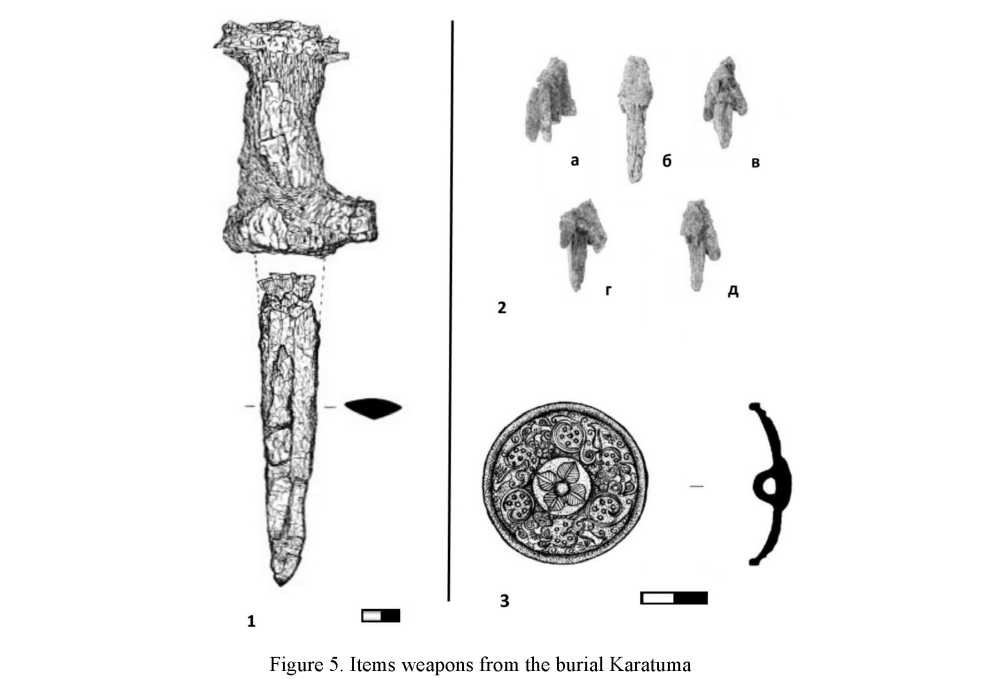
The crutches-shaped pendants from the burial mound 24 (Fig. 6, 1). Two identical crutches-shaped pendants with stapes-shaped tops and drop-shaped holes in the stem are made of copper (Cu) [10; 196]. The stapes' holes have a notch-isthmus. They date from the V century BC.
The crutch from the mound 40 has a stapes-shaped top and a solid stem (Fig. 6, 2). The «stapes» hole has a notch-isthmus. At the joint of the stem and the loop there is a fixed roller. The object is made of (Cu-6.2 % Sn-0.2 % S) [10; 196]. This refers to the first type of crutches found in Zhetysu with a loop-top existed in VI – V BC [11; 236].
The crutch-shaped pendant from the mound 55 (Fig. 6, 3). It is the iron crutch-shaped pendant with a smooth solidstem. The loop is preserved partially. Its shape can be reconstructed as ring-shaped (loopshaped), and provides a basis to relate the discovery to the second group of crutches-shaped pendants with loop-tops. This type dates to IV – III BC [12; 164].
4.3 Subject of the cult. Traditionally mirrors are considered as cult objects, applied in burial rituals. The Karatuma mirror was lying in a wooden case, the remains of which were found on the back of the object. The working part of the mirror is a disk represented by a circular shape. On its back side there are decorative elements — 4 traced concentric circles, the roller in the central part and a small hemispherical bulge in the center. The border and edge are lacking. The handle of the mirror is side and presents a monolith with the disc. In place of the junction between the disk and the handle there is a characteristic line bent at a right angle. The handle wides to the end. The section thickness of the handle is equal to the thickness of the disk. The end of the handle is rounded, the surface is not ornamented. The total length of the object, including the disk and the handle is 31.2 cm (Fig. 7).
The Karatuma mirror dates to the frames between the end of the VI and the III centuries BC [13; 236]. It is the first finding of a kind in Zhetysu. Possibly it appeared here, due to the communications with the cul-

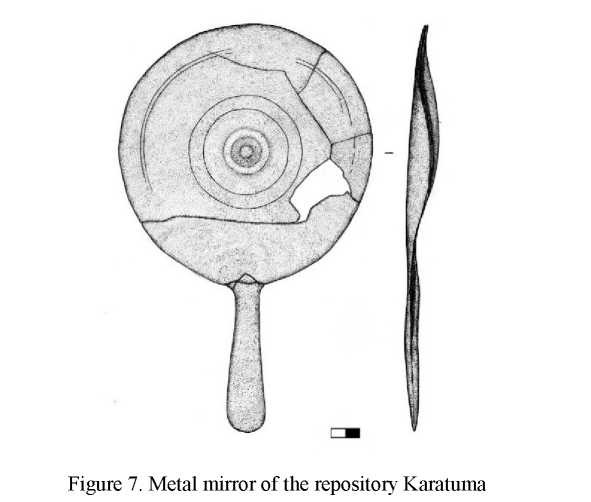
tural centers of the Central Asian region. It is highly probable that this finding marks the way in which the mirrors of this type appeared in the Ob river basin without the participation of the early Sarmatian supposed by some researchers [14; 24].
4.4 Ceramic crockery. Ceramic crockery is the most common type of the burial items not only in Karatuma but other memorials of Saka-Wusun period in Zhetysu. The most part of the ceramics from Karatumaburial ground is made of medium kneaded reddish dough with admixture of gruss and fine sand. In some cases, on the inner side of the vessels there are traces of a fabric template.
Karatuma ceramics is presented in forms, widely introduced in the memorials of Saka-Wusun period in Zhetysu: chalices, bowls, pots, jugs, mugs and cups (Fig. 8). Within the presented classes there are some variations in decoration, which served as the basis for the segregation of types and subtypes.
In general, the ceramics of Karatuma finds a wide range of analogies in the memorials, traditionally defined as Wusun. However, other categories of inventory date from more ancient times.
The complexity in differentiation of the Wusun and the Saka material culture has been repeatedly emphasized by researchers. That formed the thesis about ethno-cultural unity of Saka-Wusun antiquities [3; 29]. The chronological constructions dedicated to the Wusun ceramics, types, presented in Karatuma date to the III BC and lately [1; 266, 15; 42, 16; 136, 17; 161]. Studied the result of there search of the ceramics from Tien Shan and Ketmen Tobe K.I. Tashbayeva concluded that ceramics of early nomads of the region does not allow chronological reconstructions [18; 84]. The same types of ceramics in various combinations were used in wide chronological frames.
Thereby the comparison of Karatuma ceramics types with general chronological position of the burial ground can be used to confirm the thesis of the unity of the so-called Saka-Wusun cultural complex.
5. Chronological issue
Although the ceramics does not have chronological characteristics, we have dates obtained by comparative analysis of other categories of inventory. Also some dates were received due to radiocarbon analysis [19; 26].
On the whole, Karatuma burial ground dates broadly from VI – II BC (Fig. 9). With some clauses it is possible to narrow the dating of the burial ground to V – III BC (Fig. 10).

Cultural Affiliation
The dating of the burial ground relates to the late Saka period. In general, cultural character of the burial ground associates with Saka-Wusun antiquities of the region.
At the same time it is necessary to make a clause about the meaning given to the term «Wusun culture». In this work, we start from the classical definition of Wusun culture as a complex of Zhetysu memorials, the lower chronological boundary of which is traditionally defined as III BC. Thus, the terms «Saka» and «Wusun» are more a matter of chronological framework of the existing definitions in the historiographical tradition. The emergence of the «historical» Wusun in Zhetysu as it is known was described in Chinese sources in the first half of the II BC. It is more likely to identify them as the alkove burials of aigyrdzhal type [3, 4]. However, while researchers do not have the tools to separate the Wusun and Yuezhi layers in archeology of Zhetysu, the term «Wusun» is not fixed in the updated definition.
It is possible that the increased injuries noted in buried in the Karatuma burial ground reflects the onslaught of the Eastern nomads, provoked by the military-political activity of the Xiongnu.
Economic activity
A number of features allows us to correlate the burials from the Karatuma burial ground with agricultural population. Number of burials indicates a high density of population in the surrounding areas, what is difficult to associate with mobile lifestyle. The burial ground, like most of the so-called Wusun memorials is tied to the alluvial fan of a large river, agricultural potential of which could provide such high population density. Significant amount of stone grain grinders was found during the study of Karatuma.
The above-mentioned increase in the incidence of caries indicates the presence of high-carbonate meal, perhaps cereal in the diet.
In general, composing picture corresponds to the accumulated data about the development of agriculture in the Saka-Wusun period [20, 21].

K.A. Akishev marked an increased concentration of royal burial mounds, stand out for their enormous size, in the foothills of the southern and south-eastern Kazakhstan [22; 8]. The burials of unusual size reflect the social stratification of the population and the availability of tools to mobilize population for large public non-producing works. It can be assumed that agriculture in foothill area was one of the economic foundations of incipient statehood.
On a slight distance away from the ordinary burials of the Karatuma, which are presented in majority, there are royal burial mounds, including Chilik burial ground and royal burial mounds near the village Masak (10 and 15 km from Karatuma respectively).
It is noteworthy that the population of the Altai, which exhibited cultural affinity with Saks of Zhetysu, especially carriers of the Kamenskaya culture practiced farming widely too [23; 97]. It is possible to assume that ordinary members of society and the layer closest to them in status were buried in the Karatuma burial ground. Elite layers used the burial mounds of the royal type, known in the alluvial fan of the Shelek river.
Another problematic issue is the identification of Saka-Wusun settlements on the territory of the alluvial fan of the Shelek river, that could match as big burial ground as Karatuma. It can be assumed that it could be lost as a result of modern economic or construction activities or be overlain by alluvial deposits. Thus the search for the Early Iron Age settlement in the Shelek delta is one of the important directions of field research.
Apparently irrigated farmlands in the alluvial fan of Shelek were the economic basis of one of the Saka cultural centers of Zhetysu. Along with Shelek alluvial fans of other rivers flowing down from the ridges of the Northern Tien Shan were actively exploited. The most representative and best studied are the foothill valleys of such rivers as the Small and Big Almatinka, Talgar and Issyk.
Presented information about agriculture of the Saka in Zhetysu can be confirmed by comparison with the culture of the Saka in Aral Sea region. They also eventually began to develop agriculture in the Syrdarya delta and its tributaries. The Zhetysu Saka were developing in the same way. The difference is that the Saka in the Aral region had cities and fortifications, which we have not seen in South-East Kazakhstan. Perhaps it was influence of the architectural traditions of Khorezm and the Achaemenids, as well as the difference in the political situation. The fortified settlement Rahat in Zhetysu may be noted, but it is rather an exception.
Questions of public organization
As noted above Karatuma and other similar burial grounds were characterized by a small number of armaments in the funeral inventory. Funeral rites — a sphere which specifically reflects a synthesis of material and spiritual culture. On the one hand, it can be assumed that the religious views after transformation did not require lying the weapons in burials. On the other hand, it is possible that the population ceased to have items of weapons, which is reflected in the observable set of funerary inventory.
Specializing in agriculture reduced the ability of the population to the total military mobilization, which could provide the impetus for the appearance of social class structure. Separated social (or ethno-social) groups took the military functions, which led to the demilitarization of the ordinary population. It is natural to assume that the social position of the service class was higher than farmers'.
This is also indicated by the sizes of Karatuma burial mounds, where the burials with a weapon were identified. They have much higher values than the average for the burial ground. It can be assumed that the social status of the individuals involved in military functions was confirmed by the size of mounds and objects of weapons in the burial inventory. The sample size is too small for definitive statements, but it may be used to identify the trend.
In addition to the military class, in the materials of Karatuma there is evidence of presence of representatives of the priesthood in Saka-Wusun society. This is acknowledged by the burial, where a metal mirror was found. The context of the burial coincides with the sacerdotal burials discovered in the Altai. P.I.Shulga set a regularity, according to which typologically close mirrors relate to the burials of young women, attached to a pair sacerdotal burials, which are characterized by the remains of young and elderly women [24; 82]. The Karatuma mirror also accompanied the burial of a young woman, and the buried in a nearby burial pit individual was more mature [13].
Intercultural communication between Zhetysu and Altai in the Early Iron Age
Besides the mirror, the findings of crutches-shaped pendants and some forms of ceramics confirm the relationship with the Altai (mostly forest-steppe). It matches to the observations made on the materials of the Kamenskaya culture. The recent discovery of the fragment of a decorative ritual table foot, made in the mound, located on the alluvial fan of the Talgar River corresponds to the outline of the north-eastern dimensions of ethno-cultural contacts. The origin of such products is likely to have relation to the cultural centersof the Central Asia [25]. However, among the memorials of the Scythian-Siberian world they are most represented in the Altai Mountains.
Conclusion
In general, the Karatuma burial ground quite clearly shows the cultural character of Zhetysu in Saka- Wusun period. The materials of the Karatuma burial ground confirm the theory regarding to economic activity, ethno-cultural identity and social structure of the population. The obtained results are determined by the number of researched burials, provided a wide series of data, as well as the location of the burial ground, close in the principles of localization to the support memorials of Saka-Wusun period.
References
- Akishev, K.A., & Kushaev, G.A. (1963). Drevniaia kultura sakov i usunei doliny reki Ili [Ancient culture of the Saka and Wusun of the valley of the Ili river]. Alma-Ata: Izdatelstvo Akademii nauk KazSSR [in Russian].
- Bernshtam, A.N. (1949). Osnovnyrn etapy istorii i kultury Semirechia i Tian-Shania [The main stages of the history and culture of the Semirechye and the Tien Shan]. Sovetskaia arkheolohiia — Soviet archeology, XI, 337-384 [in Russian].
- Zadneprovskii, Yu.A. (1971). Ob etnicheskoi prinadlezhnosti pamiatnikov kochevnikov Semirechia usunskoho perioda II v. do n.e. [On the ethnicity of the monuments of nomads of the Semirechye of the Wusun period 2nd c. BC]. Strany i narody Vostoka — Countries and peoples of the East, Vol. X, 27-36 [in Russian].
- Ivanov, S.S. (2016). K probleme kulturnoho razryva na rubezhe sakskoho i usunskoho periodov v Pritianshane [To the problem of cultural rupture at the turn of the Saka and Wusun periods in Tien Shan region]. Tretii do... Poteriannoie stoletiie. Stratumplus. Arheolohiia i kulturnaia antropolohiia — Third BC ... The Lost Century. Stratumplus. Archeology and cultural anthropology, 3, 67-86 [in Russian].
- Akishev, K.A. (1978). Kurhan Issyk [The Issyk mound]. Moscow: Nauka [in Russian].
- Kitov, E. (2011). Predvaritelnyi otchet po itoham obrabotki paleoantropolohicheskoi kollektsii iz mohilnika Karatuma [Preliminary report on the results of processing the paleoanthropological collection from the Karatum burial ground]. Almaty [in Russian].
- Amirov, E.Sh. (2016). O voennom dele i hoziaistvennoi spetsifike naseleniia Zhetysu v sako-usunskii period (po materialam mohilnika Karatuma) [On military affairs and economic specifics of the population of Zhetysu in the Saka-Wusun period (based on the materials of the Karatum burial ground)]. Elektronnyi nauchnyi zhurnal «edu.e-history.kz» — Electronic scientific journal «edu.e-history.kz», 2 (06), 1–8. Retrieved from: http://edu.e-history.kz/en/books/journal/page-2?id=2%2806%29 [in Russian].
- Ivanov, S.S. (2008). Kinzhaly rannikh kochevnikov Semirechia i Tian-Shania [Daggers of the early nomads of the Semirechie and Tien Shan]. Drevnie i srednevekove kochevniki Tsentralnoi Azii — Ancient and medieval nomads of Central Asia. Barnaul, 37–41 [in Russian].
- Singayevsky, A.T. (2007). Poiasnye podveski VII v. do n.e. – I v. n.e. s territorii Ob-Irtyshskoho mezhdurechia kak kulturnyi i khronolohicheskii indicator [Belt pendants of the VII century. BC. – I c. AD from the territory of the Ob-Irtysh interfluve as a cultural and chronological indicator]. Izvestiia Altaiskoho hosudarstvennoho universiteta. Seriia: Istoriia. Politolohiia — News of Altai State University. Series: History. Political science, 4/3, 161–173 [in Russian].
- Voyakin, D.A., & Park, D.S. (2012). Metallohraficheskoe izuchenie metallicheskikh izdelii nekropolia Karatuma [Metallographic study of metal products of necropolis of Karatuma]. Proceedings from Almaty. History of the Millennium: Mezhdunarodnaia nauchno-prakticheskaia konferentsiia «Drevniaia i srednevekovaia urbanizatsiia Evrazii: vozniknovenie, razvitie i vozrast horoda Almaty» (17–18 noiabria 2010 hoda) — Scientific-practical conference «Ancient and medieval urbanization of Eurasia: the origin, development and age of the city of Almaty». (рр. 195–200). Almaty [in Russian].
- Ivanov, S.S. (2012). «Kostylki» — elementy boevykh poiasov rannikh kochevnikov Semirechia i Tian-Shania [«Crutch- es» — elements of the combat belts of the early nomads of the Semirechye and the Tien Shan]. Proceedings from IV Orazbaev readings. Problems and achievements of the Domestic Archeology and Ethnology in the 21st Century: Mezhdunarodnaia nauchnaia konferentsiia — International scientific conference. (рр. 234–240). Almaty [in Russian].
- Amirov, E.Sh. (2015). Podveski-kostylki iz mohilnika Karatuma (k rasshireniiu serii iz doliny r. Ili) [Pendants-crutches from the burial ground of Karatuma (to the expansion of the series from the valley of the Ili river)]. Proceedings from VIII Orazbaev readings. Kazakhstan archeology and ethnology: past, present, future: Mezhdunarodnaia nauchnaia konferentsiia — International scientific conference. (рр. 163–165). Almaty [in Russian].
- Amirov, E.Sh. (2015). Zerkalo sredneaziatskoho oblika iz mohilnika Karatuma (k postanovke problemy vydeleniia zhrecheskikh pohrebenii sakov Semirechia) [Mirror of the Central Asian appearance from the burial ground of Karatuma (to the formulation of the problem of singing out the priestly burials of the Saka of the Semirechie)]. Vestnik KazNU — Bulletin of KazNU, 1 (76), 234–239 [in Russian].
- Mogilnikov, V.A., & Umanskii, A.P. (1995). Dva zerkala iz Novotroitskikh kurhanov [Two mirrors from the Novotroitsk mounds]. Pamiatniki Evrazii skifo-sarmatskoi epokhi — Monuments of Eurasia of the Scythian-Sarmatian epoch. Moscow, 19–31 [in Russian].
- Dosymbaeva, A.M. (2007). Kulturnyi kompleks tiurkskikh kochevnikov Zhetysu II v. do n.e. – V v. n.e. [Cultural complex of the Turkic nomads Zhetysu II c. BC. – V c. AD]. Almaty: Tiurkskoe nasledie [in Russian].
- Maksimova, A.G. (1972). Kurhannyi mohilnik v urochishche Kyzyl-Kainar [Kurgan burial ground in the tract Kyzyl- Kainar]. Poiski i raskopki v Kazakhstane — Searches and excavations in Kazakhstan. Alma-Ata, 123–138 [in Russian].
- Maksimova, A.G. (1975). Uzun-Bulak i Shoshkala — mohilniki usunskoho vremeni [Uzun-Bulak and Shoshkala — burial grounds of Wusun time]. Drevnosti Kazakhstana — Antiquities of Kazakhstan. Alma-Ata: Nauka, 141–161 [in Russian].
- Tashbaeva, K.I. (2011). Kultura rannikh kochevnikov Tian-Shania i Alaia (I tys. do n.e.) [Culture of the early nomads of the Tien Shan and the Alai (1st millennium BC)]. Bishkek: Ilim [in Russian].
- Motuzaite Matuzeviciute, G., Lightfoot, E., O'Connell, T.C., Voyakin, D., Liu, X., Loman, V., Svyatko, S., Usmanova, E., & Jones, M.K. (2015). The extent of cereal cultivation among the Bronze Age is determined using stable isotope analysis of bone collagen. Journal of Archaeological Science, 59, 23–24.
- Baipakov, K.M. (2008). Horod i step v drevnosti: osedlost i zemledelie u sakov i usunei Zhetysu [The city and the steppe in antiquity: Pale and agriculture in the Saka and Wusun of Zhetysu]. Izvestiia NAN RK. Seriia obshhestvennykh nauk — News of NAS RK. Series of social sciences, 1 (254), 3–25 [in Russian].
- Spengler III, R.N., Chang, C., & Tourtellotte, P. (2013). Agricultural production in the Central Asian mountains: Tuzusai, Kazakhstan (410–150 B.C.). Journal of Field Archaeology, Vol. 38, 1, 68–85.
- Akishev, K.A. (1994). Elitnye kurhany stepei Evrazii v skifo-sarmatskuiu epokhu [Elite mounds of the Eurasian steppes in the Scythian-Sarmatian epoch]. Fenomen elitarnykh kurhanov Severnoho Tian-Shania — Phenomenon of elite barrows of the Northern Tien Shan. Saint Petersburg: IIMK, 8–11 [in Russian].
- Mogilnikov, V.A. (1997). Naselenie Verkhneho Priobia v seredine — vtoroi polovine I tysiacheletiia do n.e. [The population of the Upper Ob region in the middle — second half of the I millennium BC]. Moscow: IA RAN [in Russian].
- Shulga, P.I. (1999). Zhrecheskie parnye zakhoroneniia s zerkalami-pohremushkami (k postanovke problemy) [Priestly paired burials with mirrors-rattles (to the formulation of the problem)]. Drevnosti Altaia. Izvestiia laboratorii arheolohii — Antiquities of Altai. News of the Laboratory of Archeology, 5, 82–91 [in Russian].
- Amirov, E.Sh., & Seitkaliev, M.K. (2017). Nakhodka akhemenidskoi mebelnoi furnitury v sakskom pohrebenii Semirechia [A find of Achaemenid Furniture Accessory in a Saka Burial in Semirechye]. Strela vremeni. Stratum plus. Arkheolohiia i kulturnaia antropolohiia — Scythia. Time Arrow. Stratum plus. Archeology and cultural anthropology, 3, 329–334 [in Russian].